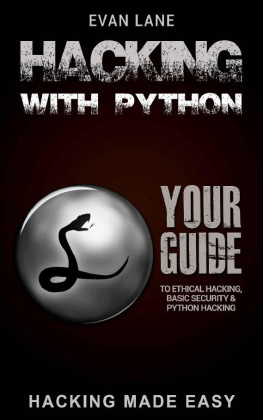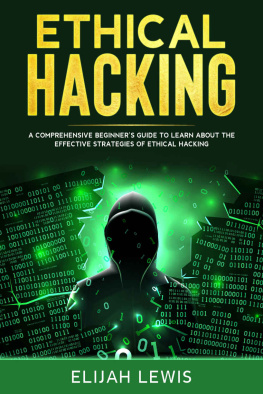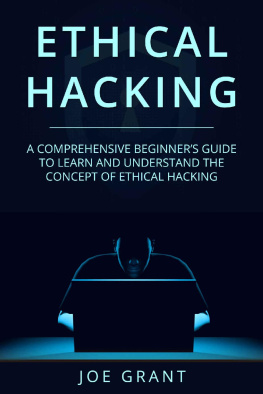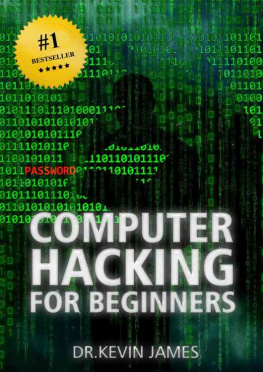Hacking with Python
Your Guide to Ethical Hacking, Basic Security, Penetration Testing, and Python Hacking
Hacking Made Easy
Evan Lane
Copyright 2017 Evan Lane. All rights reserved.
Printed in the USA
The information in this book represents only the view of the author. As of the date of publication, this book is presented strictly for informational purposes only. Every attempt to verifying the information in this book has been done and the author assumes no responsibility for errors, omissions, or inaccuracies.
In no way is it legal to reproduce, duplicate, or transmit any part of this document in either electronic means or in printed format. Recording of this publication is strictly prohibited and any storage of this document is not allowed unless with written permission from the publisher. All rights reserved.
Respective authors own all copyrights not held by the publisher.
The information herein is offered for informational purposes solely, and is universal as so. The presentation of the information is without contract or any type of guarantee assurance.
The trademarks that are used are without any consent, and the publication of the trademark is without permission or backing by the trademark owner. All trademarks and brands within this book are for clarifying purposes only and are the owned by the owners themselves, not affiliated with this document.
Contents
Introduction
Hacking is a word that has many different meanings to people. Most are used to hearing it in a negative light, such as when a black hat hacker breaks into a big companys website and steals lots of personal information, or when someone breaks into your bank account to steal money. But there are many other forms of hacking as well and you can even learn hacking as a method to protect your network from others who may want to get the information. This book is going to spend time looking at some of the basics of hacking with Python so you can navigate through the system and perform some of your own hacks.
In this book, we are going to start with some of the basics of hacking, such as the difference between the white hat and black hat hacker and some of the things that you will need to know to get started. We will then move on to some of the different hacks that you can do including a password hack, a network hack, and a man in the middle hack to name a few. Each of these allow you to get different information off a computer system, and if you would like to know more about how your own personal network works or how to protect it from other hackers, learning how to do some of these attacks can make a big difference.
When you are ready to learn some of the basics that come with hacking and how to do these attacks with the help of Python, look through this book and learn what you need to perform some of these hacks on your own!
Chapter 1
Some of the Basics of Hacking
Hacking is a term that means different things to each person who hears it. To someone who is into coding and the world of computers, it may mean an exciting opportunity to learn more about computers and to see how far you can go with your skills. To someone who is looking to get private information and maybe make some money in the process, hacking is a way to get onto systems and steal personal information. And to the rest of us, hacking is usually seen as a process of someone getting onto our computer or our systems and taking information that they do not have permission to get.
While these can be ways that hacking is used, the process of hacking is usually referred to as the act of using a piece of software or a computer in some manner that it wasnt intended for. Sometimes this is done to protect your own device, to learn how the device works, to improve the device, or to get onto a system that you cant be on.
There are three main types of hackers that you will find and while all of them are going to use the same methods to get what they want from a system, they are all going to have different reasons for doing so. The three main categories for hacking include:
- Black hat: this is the type of hacking that most people think of first. These are the bad guys, the criminal hackers who will get on a system for some malicious purpose. They may just get into a private system to steal banking and other personal information or they could get onto the system of a large business and then cause a lot of chaos. Typically, these kinds of hackers are going to delete files, modify devices, or steal data to complete the hack.
- White hat: these are typically seen as the good guys in hacking. These are the ones who are trying to protect their own systems, or the system of someone they are working for, from being hacked. Many big organizations and even places like hospitals will hire white hat hackers to help protect personal and financial information. Their job is to be on a system and try to find ways that black hat hackers may try to get on the system, and then fix these issues to prevent anyone getting onto the system who shouldnt be there.
- Grey hat: this is a hacker who is somewhere in the middle of the two listed above. These individuals are going to use both illegal and legal techniques in order to exploit or improve a system. Usually, the grey hat hacker is going to try and get on the system of a business or another person, but they dont have malicious intents and they will tell the owner of the system what they were able to find. Often these hackers are just curious to see if they can get on a system that they dont have access to, but they dont really want to use the information.
In this guidebook, we are going to spend some time talking about hacking and some of the techniques that you can learn when it comes to protecting your system. With that said, illegal hacking or any attempts to get onto a system that you do not have express permission to be on is not condoned or encouraged in this guidebook. Using these techniques and tips are great for protecting your own personal computer or network, but using them to access other systems without permission is illegal and can be punishable by law.
What Skills Do I Need to Begin Hacking?
Hacking is a skill that will need some practice to master, but it isnt too difficult to learn. As long as you are familiar with how your computer works and you can follow some of the instructions that we will outline in this book, you will easily be able to use some of these hacks on your system. One thing that you need to have in order to do the codes in this book is a basic understanding of how to code with Python. If you dont know how to code with Python yet, I suggest reading Python Programming: A Step by Step Beginners Guide to Coding with Python in 7 Days or Less! (yours truly) so that you can understand what we talk about with the different hacks.
Some of the other computer skills that you will need to begin hacking with Python include:
- Computer skills: you dont need to be an expert in hacking, you just need to be able to do a bit more than the basics. You need to know how to do things like edit some of the registry files, how to work with a network, and how to work with the command lines in Windows to make the hacking work.
- Networking skills: most of the attacks that you want to do will be online so it is important to have some understanding of networking concepts and terms. If you dont know what VPN, DNS, Ports, Routers, and other networking terms, you may want to spend some time learning them to help you get started.
- Linux OS: the Linux operating system is one of the easiest to use when it comes to hacking compared to Mac and Windows operating systems. Many of the best hacking tools available will use Linux and this operating system will already have Python inside of it.















